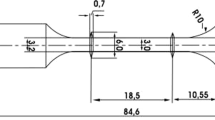Abstract
Tube hydroforming is a metal-forming technology process with expanding applications, particularly that is growing used in the production of hollow and complex-shaped parts in automotive and aerospace industry. One of the challenges of industrial tube hydroforming processes is the low formability of multi-layered tubes. Friction plays an important role in tube hydroforming due to the high contact pressure between the surface of the die and tube. Friction force affects the tube formability by preventing the material flow toward the deformation zone. In this research, a new sealing method is used to eliminate the internal pressure in the feeding zone. As a result of this, the friction force between the tube and the die is removed from this zone and flowing of the material toward the deformation zone is improved. First, the new sealing method was examined in a free bulge formation of aluminum tubes. The results show that the new sealing method can increase the formability of aluminum tubes by 19% compared with the conventional sealing method. Finite element simulation of the free bulge formation was performed in Abaqus software with different process parameters. During the simulations, the forming limit curve obtained from the experimental tests was used for the prediction of necking. Results showed that increasing of the friction coefficient increases the formability of the aluminum tubes in the new sealing method. In addition to that, the formability of parts was improved in bi-layered tubes by this technique.
Similar content being viewed by others
References
Plancak M, Vollertsen F, Woitschig J (2005) Analysis, finite element simulation and experimental investigation of friction in tube hydroforming. J Mater Process Technol 170(1–2):220–228
Ngaile G, Yang C (2009) Analytical model for the characterization of the guiding zone tribotest for tube hydroforming. J Manuf Sci Eng 131.2:021008
Vollertsen F, Plancak M (2002) On possibilities for the determination of the coefficient of friction in hydroforming of tubes. J Mater Process Technol 125–126:412–420
Alaswad A, Olabi AG, Benyounis KY (2011) Integration of finite element analysis and design of experiments to analyse the geometrical factors in bi-layered tube hydroforming. Mater Des 32(2):838–850
Olabi AG, Alaswad A (2011) Experimental and finite element investigation of formability and failures in bi-layered tube hydroforming. Adv Eng Softw 42(10):815–820
Koc M (2003) Tribological issues in the tube hydroforming process—selection of a lubricant for robust process conditions for an automotive structural frame part. J Manuf Sci Eng 125(3):484–492
Prier M, Schmoeckel D (1999) Tribology of internal high pressure forming. MAT-INFO Werksstoff-Information osgesellschaft mbH, Humburger Allee 26:379–390
Yi HK, Yim HS, Lee GY, Lee SM, Chung GS, Moon Y-H (2011) Experimental investigation of friction coefficient in tube hydroforming. Trans Nonferrous Metals Soc China 21:s194–s198
Fiorentino A, Ceretti E, Giardini C (2013) Tube hydroforming compression test for friction estimation—numerical inverse method, application, and analysis. Int J Adv Manuf Technol 64(5):695–705
Yang L, Wu C, He Y (2016) Dynamic frictional characteristics for the pulsating hydroforming of tubes. Int J Adv Manuf Technol 86(1–4):347–357
Abdelkefi, Abir, et al. (2016) “Evaluation of the friction coefficient in tube hydroforming with the “corner filling test” in a square section die.” The International Journal of Advanced Manufacturing Technology: 1–9
Orban H, Hu SJ (2007) Analytical modeling of wall thinning during corner filling in structural tube hydroforming. J Mater Process Technol 194(1–3):7–14
Xu X, Zhang W, Li S, Lin Z (2009) Study of tube hydroforming in a trapezoid-sectional die. Thin-Walled Struct 47(11):1397–1403
Nikhare C, Weiss M, Hodgson PD (2009) FEA comparison of high and low pressure tube hydroforming of TRIP steel. Comput Mater Sci 47(1):146–152
Fiorentino A, Ceretti E, Braga D, Marzi R (2010) Friction in asymmetric feeding tube hydroforming. Int J Mater Form 3(1):275–278
Abdelkefi A et al (2016) Effect of the lubrication between the tube and the die on the corner filling when hydroforming of different cross-sectional shapes. Int J Adv Manuf Technol 87(1–4):1169–1181
Fiorentino, Antonio, et al. (2009) “Experimental study of lubrication influence in the production of hydroformed T-joint tubes.” Key Engineering Materials. Vol. 410. Trans Tech Publications
Keeler Stuart P (1968) Circular grid system—a valuable aid for evaluating sheet metal formability. No. 680092. SAE Technical Paper
Goodwin, Gorton M. (1968) Application of strain analysis to sheet metal forming problems in the press shop. No. 680093. SAE technical paper
C. Rossard, (1976) Mise en forme des métaux et alliages, CNRS, Paris.
Author information
Authors and Affiliations
Corresponding author
Rights and permissions
About this article
Cite this article
Karami, J.S., Sheikhi, M.M., Payganeh, G. et al. Experimental and numerical investigation of single and bi-layered tube hydroforming using a new sealing technique. Int J Adv Manuf Technol 92, 4169–4182 (2017). https://doi.org/10.1007/s00170-017-0406-y
Received:
Accepted:
Published:
Issue Date:
DOI: https://doi.org/10.1007/s00170-017-0406-y




